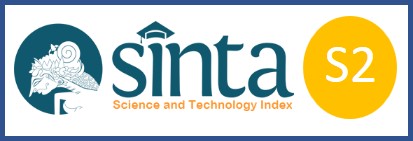Government Expenditure in Maluku: Autoregressive Vector Analysis
Downloads
In 1999 Indonesian government implementing the law of regional autonomy, direct impact to this implementation is every province has to manage the economic development of each province. It also happened in Maluku province, the increase of the APBD (Regional Income and expenditure Budget) supposed to be a instrument of the economic growth in Maluku. But, in fact Maluku still a 4th poorest province in Indonesia and have a highest unemployment rate in Indonesia, the effectiveness of the budget realization become the main problem, according to the BPS Maluku (National Bureau of statistic, Maluku Branch) most of the government budget is using as a routine expenditure (83.4%) and the rest of it (29.68%) is using as a capital expenditure, which is can't push the economic growth acceleration. This study uses a VAR (Vector Autoregressive) Model, to determine effect of the government spending to economic growth in Maluku and make a forecasting models to give a policy recommendation to the Government of Maluku Province, the data that used in this study is a time series data from 1997-2016 sourced from BPS Maluku.The result shows that the government expenditure in Maluku Province are determined by various variable both exogenous (government policy: such as Oil and Non-oil revenue) and endogenous variable (GDP and Fixed Capital formation). the other result of estimation using Impulse Response Function and Variance Decomposition analysis show all the variables in the short run and in the long run positively impact the Government Expenditure in Maluku.
Keywords: Government Expenditure, Economic Growth, VAR Models.
JEL: 010; C01
Anggraini, Rinda Ayun et al. (2016). "Pengeluaran Pemerintah dan Pertumbuhan Ekonomi Regional - Studi Kasus Data Panel di Indonesia.” International Journal of Scientific & Technology Research.
Ardiyanto, D. (2013). Analisa Keterkaitan Pengeluaran Pemerintah Dan Produk Domestik Bruto Di Indonesia: Pendekatan Vector Error Correction Model (Vecm) (Doctoral dissertation, Universitas Brawijaya).
Bastias, D. D., & Evi Yulia, P. (2010). Analisis Pengaruh Pengeluaran Pemerintah Atas Pendidikan, Kesehatan dan Infrastruktur Terhadap Pertumbuhan Ekonomi Indonesia Periode 1969-2009 (Doctoral dissertation, Universitas Diponegoro).
Buchanan, J. M., & Musgrave, R. A. (1999). Public finance and public choice: two contrasting visions of the State. MIT press.
Durongkaveroj, Wannaphong. (2014). Government Expenditure Determination on the Basis of Macroeconomics. https://ideas.repec.org/p/pra/mpra pa/55048.html.
Enders, W. (2015). Applied econometric time series fourth edition.
Fasano, U., & Wang, Q. (2002). Testing the relationship between government spending and revenue: Evidence from GCC countries.
Galí, J., López-Salido, J. D., & Vallés, J. (2007). Understanding the effects of government spending on consumption. Journal of the european economic association, 5(1), 227-270.
Hasnul, A. G. (2015). The effects of government expenditure on economic growth: the case of Malaysia. .” Munich Personal RePEc Archive.
Mankiw, N. Gregory. (2012). "Principles of Economics 6th Edition.” Cengage Learning.
Mehrara, M., & Rezaei, A. A. (2014). The relationship between government revenue and government expenditure in Iran. International Journal of Academic Research in Business and Social Sciences, 4(3), 171.
Nelimarkka, J. (2017). The effects of government spending under anticipation: the noncausal VAR approach. HECER Discussion Paper. 418: 1–30. http://hdl.handle.net/10138/22288 9.
Nwosu, D. C., & Okafor, H. O. (2014). Government revenue and expenditure in Nigeria: A disaggregated analysis. Asian Economic and Financial Review, 4(7), 877-892.
Obioma, E. C., & Ozughalu, U. M. (2010). An examination of the relationship between government revenue and government expenditure in Nigeria: Cointegration and causality approach. Economic and Financial Review, 48(2), 35-57.
Peacock, A. T., & Wiseman, J. (1961). Front matter, the growth of public expenditure in the United Kingdom. In The growth of public expenditure in the United Kingdom (pp. 32-0). Princeton University Press.
Rahayu, S. E. (2011). Analisis pengaruh pengeluaran pemerintah terhadap pertumbuhan ekonomi di sumatera Utara. Jurnal Ilmiah Manajemen dan Bisnis UMSU, 11(2).
Rijoly, J. C. D., & Rum, I. A. (2017). Analisis Tingkat Pengangguran di Maluku Sebagai Provinsi Kepulauan. ISEI Economic Review, 1(2), 38-41.
Sims, C. A. (1980). Macroeconomics and reality. Econometrica: journal of the Econometric Society, 1-48.
Sinha, Dipendra. (2010). "Government expenditure and economic growth in China.” Computer Application and System Modeling (ICCASM), 2010 International Conference on 13(2): 71–80.
Shelton, C. A. (2007). The size and composition of government expenditure. Journal of Public Economics, 91(11-12), 2230-2260.
Sukirno, S. (2003). Computer Pengantar Teori Mikroekonomi.
Copyright (c) 2019 Jacobus Cliff Diky Rijoly

This work is licensed under a Creative Commons Attribution-ShareAlike 4.0 International License.
JIET (Jurnal Ilmu Ekonomi Terapan) (p-ISSN: 2541-1470; e-ISSN: 2528-1879) is licensed under a Creative Commons Attribution-ShareAlike 4.0 International License
Authors who publish with JIET (Jurnal Ilmu Ekonomi Terapan) agree to the following terms:
- The journal allows the author to hold the copyright of the article without restrictions.
- The journal allows the author(s) to retain publishing rights without restrictions
- The legal formal aspect of journal publication accessibility refers to Creative Commons Attribution ShareAlike 4.0 International License (CC BY-SA).












